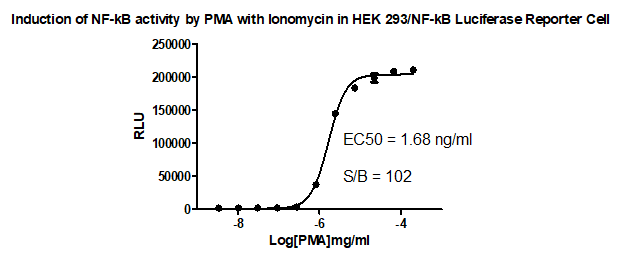

| RQP74026 | |
| I. Background | |
| Nuclear factor-κB (NF-κB)/Rel proteins include NF-κB2 p52/p100, NF-κB1 p50/p105, c-Rel, RelA/p65, and RelB. These proteins function as dimeric transcription factors that control genes regulating a broad range of biological processes including innate and adaptive immunity, inflammation, stress responses, B cell development, and lymphoid organogenesis. In the classical (or canonical) pathway, NF-κB/Rel proteins are bound and inhibited by IκB proteins. Proinflammatory cytokines, LPS, growth factors, and antigen receptors activate an IKK complex (IKKβ, IKKα, and NEMO), which phosphorylates IκB proteins. Phosphorylation of IκB leads to its ubiquitination and proteasomal degradation, freeing NF-κB/Rel complexes. Active NF-κB/Rel complexes are further activated by phosphorylation and translocate to the nucleus where they induce target gene expression. In the alternative (or noncanonical) NF-κB pathway, NF-κB2 p100/ RelB complexes are inactive in the cytoplasm. Signaling through a subset of receptors, including LTβR, CD40, and BR3, activates the kinase NIK, which in turn activates IKKα complexes that phosphorylate C-terminal residues in NF-κB2 p100. Phosphorylation of NF-κB2 p100 leads to its ubiquitination and proteasomal processing to NF-κB2 p52, creating transcriptionally competent NF-κB p52/RelB complexes that translocate to the nucleus and induce target gene expression. | |
| II. Description | |
| The NF-κB reporter (luc)-HEK293 cell line is designed for monitoring the nuclear factor Kappa B (NF-κB) signal transduction pathways. It contains a firefly luciferase gene driven by four copies of NF-κB response element located upstream of the minimal TATA promoter. After activation by pro-inflammatory cytokines or stimulants of lymphokine receptors, endogenous NF-κB transcription factors bind to the DNA response elements, inducing transcription of the luciferase reporter gene. | |
| III. Introduction | |
| Host Cell: | HEK293 |
| Expressed gene: | NF-kB-Luciferase |
| Stability: | 32 passages |
| Synonym(s): | NF-κB cell line, NFkappaB cell line, luciferase reporter, NF-kB cell line, NFkB cell line |
| Freeze Medium: | 90% FBS+10% DMSO |
| Culture Medium: | DMEM+10%FBS+150ug/ml hygromycin |
| Mycoplasma Testing: | Negative |
| Storage: | Liquid nitrogen |
| Application(s): | The NF-kB reporter cell line is designed for screening inhibitors of NF-kB and for monitoring NF-kB signaling pathway activity. |
| IV. Description of Host Cell Line | |
| Organism: | Homo sapiens, human |
| Tissue: | Embryonic kidney |
| Disease: | Normal |
| Morphology: | Epitheloid cell |
| Growth Properties: | Adherent |
| Ⅴ. Representative Data | |
 | |
Figure 1. Detect Luciferase assay by Promega Bright-Glo Luciferase Assay System. HEK293/NF-κB Luciferase Reporter cells were stimulated by Ionomycin, the S/B was 102-fold. | |